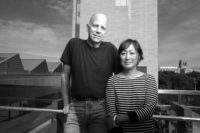Ask Tod Williams and Billie Tsien—designers of the Barnes Foundation in Philadelphia and the erstwhile Folk Art Museum in New York—and they’ll tell you they don’t do houses. A few years ago, David Walentas, the real-estate tycoon who transformed part of Brooklyn’s derelict waterfront into one of New York’s most desirable neighborhoods, and his wife, Jane, needed an architect for a house they were building on Long Island’s East End. They didn’t think Tod and Billie—whom the couple, as patrons of the arts, had known for years—would do it.
Additional Content:
Jump to credits & specifications
“We wanted a simple concrete box,” says David. In fact, the Walentases had originally hired a local architect to deliver that. But nothing is ever as simple as it seems. By the time they came to Tod Williams Billie Tsien Architects | Partners (TWBTA), plans for a bar-shaped structure were already far along, and the couple didn’t want to change that. David and Jane, as it turns out, had very strong feelings about what they wanted. After developing several million square feet of residential space, and living in numerous renovated lofts or old Victorians in New York City, Connecticut, and the Hamptons, this was the first house they were building for themselves. “The last place we had was a 1670 farmhouse, on an equestrian estate in Bridgehampton, with low ceilings and small windows,” explains Jane. “We wanted something contemporary. And some of the places we looked at to buy were just too beautiful.” After giving up riding and playing polo, they also wanted to return to a strip of beach in Southampton where they had lived in the 1970s in a Ward Bennett–designed house they bought for $200,000. (It recently sold for over $17 million.)
As it also turns out, TWBTA does do houses—some pretty nice ones, in fact. “I believe all the original owners still live in them,” Williams says of the smattering of private residences, most of them in that part of Long Island, that the venerable New York–based firm has designed during several decades of practice. The studio’s extensive experience with institutional buildings, on the other hand, and the difficult building process those often entail, was particularly useful in what would become a complex construction. “Poured, board-formed concrete is very unforgiving,” says David. “There are no do-overs.”
That might also explain why a concrete house is such an anomaly here. While the locale might be an ideal summer escape, the weather in winter can be brutal, especially on this ever-so-narrow strip of flat, open land facing Shinnecock Bay to the north and the Atlantic Ocean to the south. It took over two years to pour all the concrete walls and floor slabs, section by section, when the temperature was not too hot, and not too cold. The builder, who specializes in commercial structures in the area but enjoys taking on the occasional architectural challenge, started with the caretaker’s pavilion embedded in the front lawn by the tennis court, working out any glitches there. That space is connected by tunnel to the vast, flood-resistant basement, where storage, mechanical, and electrical rooms are located.
The process wasn’t without its trying moments. The two stories above ground are surprisingly modest in size, but the concrete there needed to be pristine. “Tod recommended tenting the formwork,” recalls David, who opted not to do so. As luck would have it, an unexpected storm hit, warping much of the Southern yellow pine that was left exposed. Adds David, “The neighbors have tented the house they have under construction now.”
That calamity behind them, the team was then faced with an extraordinary coordination effort so that each pour, alternating between interior and exterior walls and slabs, accommodated all the rebar, wires, radiant heating, track lighting, recessed cans, and depressions (for in-wall iPads that control the lighting, shades, security, audio, and mechanical systems), as well as a last-minute request from the clients to embed additional uplights throughout the lower-level ceiling. “That ceiling was the most complex thing in the entire house,” says project architect Peter DePasquale, referring to the 8-inch-thick, cantilevering, post-tensioned structural slab. “It’s so dense. If you took an X-ray of it, you’d see more non-concrete than concrete.” To keep the layers of concrete thermally isolated from each other, the exterior walls were poured against balcony connectors made of stainless steel and polystyrene insulation protruding from the floor slabs.
The design of the southern, oceanfront facade presented perhaps an equal but different challenge. The architects insisted on including a two-story, occupiable brise-soleil, both to protect against the harsh sun and for aesthetic reasons. “We really had to convince the clients on that one,” says Tsien. “Finally, we told them that without it, the house would look like a motel on the beach.” Set 2 inches from the facade glass, the detached brise-soleil is structurally independent.
Great care was taken with interior details, the kind for which TWBTA is known. An impressive cantilevering stair, hanging off a vertical steel truss extending from the basement, features treads of a polished bleu de savoie stone that almost matches the concrete but is noticeably a step above. Doors and shelves in raw teak add warm accents to both the kitchen pantry and bedroom closets. The master suite is separated from the guest quarters by a sunroom adjacent to the open stair. A metal roof over that area can be manually retracted by turning a wheel along the wall, exposing it to the sky and wind. “They hardly have guests stay over, so no one ever really sees the second floor,” Williams says. “There needed to be a reason to look up.”
But, mostly, David and Jane look out—to the incredible water views on either side, to the ocean and the bay—that this inimitable site offers from both the living spaces on the lower level and the bedrooms upstairs. As for the house itself, the clients call it tight and cozy. “Our friends are happily surprised,” Jane admits. “They expected a bunker.” And though she says the stressful construction led Williams to refer to the project as “that goddamn concrete house,” she and her husband didn’t mind. “We’re builders,” David says. “We loved the process.”
CreditsArchitect: Tod Williams Billie Tsien Architects | Partners — Tod Williams, Billie
Engineering: Gilsanz Murray Steficek (structural); Ettinger Engineering Associates, Weber & Grahn (m/e/p)
Consultants: Reg Hough Associates (concrete); PW Grosser Consulting (geothermal/PV); Steven Winter Associates (energy efficiency, certification)
General contractor: Two Trees Management — Alex Forden, Joe Fowler |
SpecificationsCast concrete Ruttura & Sons
Stone Precision Stone, ABC Stone
Steel & glass window wall system Roschmann Steel & Glass Construction, Secco Sistemi
Photovoltaics Greenlogic
Hardware Lowe Hardware
Railings Studio 40
Lighting Viabizzuno, Visual Lighting Technologies, Boca Flasher
Controls Lutron, Savant
Bathroom fixtures Fantini
Solid surfacing and wood doors Descience Laboratories
Kitchen cabinets St. Charles of New York
Operable roof hatch and folding steel doors Turner Exhibits |














Post a comment to this article
Report Abusive Comment